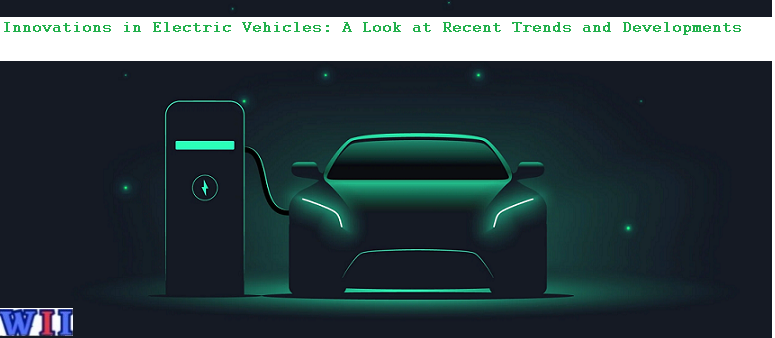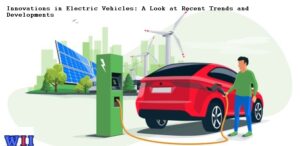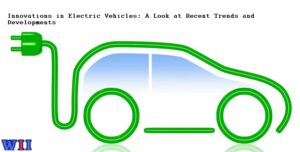Innovations in Electric Vehicles: The automotive landscape is undergoing a radical revolution, the likes of which we have not witnessed since the first Model T rolled off the assembly line. The driving force behind this transformative shift is the increasing global adoption of electric vehicles (EVs). The following blog will navigate the twists and turns of this dynamic sector, delving into the newest developments and innovations pushing the electric vehicle industry into overdrive.
Advancements in Battery Technology
The heart of every electric vehicle lies in its battery. Lithium-ion batteries, the mainstay of the electric vehicle industry, have seen significant breakthroughs in recent years. Scientists have engineered novel cathode and anode materials, enhancing their energy density and longevity.
The new promise, however, lies in solid-state batteries. By replacing liquid electrolytes with solid ones, these batteries promise increased safety, higher energy densities, and longer lifespans, potentially revolutionizing EV technology. This advancement is juxtaposed with improvements in battery efficiency, leading to longer driving ranges and thus, addressing one of the significant concerns about EVs: range anxiety.
Further making strides in this arena are rapid charging solutions. From supercharging stations to battery swap technology, these developments have greatly mitigated the long-standing challenge of slow charging times, further paving the way for mass EV adoption.
Evolution of Electric Motors
Equally critical in the EV narrative is the evolution of electric motors. Permanent magnet motors have come to the fore, given their advantages in terms of efficiency and power density. The robust design and lower maintenance requirements of these motors make them an attractive proposition for EV manufacturers.
On the other hand, induction motors serve as cost-effective alternatives, with key benefits including high-speed operation and the absence of permanent magnets, reducing overall costs. Further augmenting performance are dual-motor configurations, which offer superior torque, speed, and power.
These advancements have enabled the reduction and seamless integration of motors, enhancing the overall vehicle efficiency, and signaling yet another leap forward for the EV industry.
Autonomous Driving Capabilities
Emerging in parallel to these advancements is the integration of artificial intelligence (AI) and machine learning in EVs. Advanced driver-assistance systems (ADAS) have taken centre stage, offering features like lane keeping assist, adaptive cruise control, and automatic emergency braking.
Even more impressive are level 4 and 5 autonomous driving features. These full and high automation systems have the potential to transform our roads, making human drivers almost redundant. By marrying safety and convenience, autonomous capabilities may become a game-changer for the acceptance and expansion of EVs.
Design and Materials Innovations
In the quest for efficiency, EV manufacturers are innovating beyond the power train. Lightweight materials like carbon fiber and aluminum are being increasingly employed to shed vehicle weight and thus, boost energy efficiency. Alongside, aerodynamic enhancements are playing a crucial role in reducing drag, further increasing the vehicle’s range.
From skateboard platforms to compact e-axles, innovative vehicle architectures are contributing towards efficient packaging, improving the space, and comfort inside the vehicle. Another groundbreaking innovation is the integration of renewable energy technologies, such as solar panels, extending the vehicle’s range and reducing reliance on charging infrastructure.
Charging Infrastructure Development
Key to widespread EV adoption is the robustness of the charging infrastructure. Public charging networks are mushrooming around the globe, ensuring EV owners aren’t left stranded. High-power charging stations and ultra-fast charging capabilities are further sweetening the deal.
Wireless charging technology is an up-and-coming trend, eliminating the need for plugging in, and providing unparalleled convenience. Adding another layer of complexity is smart grid integration, which ensures demand management and prevents grid overload during peak charging times.
Vehicle-to-Grid (V2G) Technology
Harnessing the untapped potential of parked EVs is vehicle-to-grid technology. This innovation allows the bi-directional flow of electricity, enabling EVs to return excess power back to the grid. The benefits are manifold, including grid balancing and supporting the integration of renewable energy.
However, widespread implementation of V2G systems faces hurdles such as increased battery degradation and the need for smart grid infrastructure. Despite these challenges, the future of V2G technology holds immense potential, providing yet another feather in the cap for electric vehicles.
Electric Vehicle Ecosystem
The electrification movement has given rise to a diverse ecosystem encompassing traditional automakers, charging infrastructure providers, EV startups, and technology companies. Traditional automakers are progressively augmenting their portfolio with EVs, from compact cars to heavy-duty trucks.
Startups are not just introducing disruptive technologies but also challenging conventional automotive business models. Meanwhile, collaborations between automakers and technology companies are becoming more commonplace, with the joint aim of accelerating the pace of innovation and driving the mass adoption of EVs.
Sustainable Supply Chain Initiatives
The surge in EV production has necessitated a relook into the supply chain. Ethical sourcing of raw materials, particularly for batteries, has become a key focus. In parallel, recycling initiatives and second-life applications for batteries are gaining traction, closing the loop on the battery life cycle.
From manufacturing to delivery, efforts are underway to minimize the carbon footprint associated with EVs. Manufacturers are also recognizing their extended producer responsibilities (EPR), implementing programs to manage end-of-life vehicles and parts responsibly.
Government Policies and Incentives
Government policies have a crucial role to play in spurring EV adoption. Regulations and emission standards are compelling automakers to ramp up EV production, while subsidies and tax incentives are making electric vehicles more affordable for consumers. Government funding is also catalyzing the development of charging infrastructure, further accelerating the EV transition.
The future of these policy trends holds significant sway over the fate of the electric vehicle industry. It is imperative that governments around the world continue to cultivate an environment conducive to the growth and development of EVs.
EV Adoption and Market Trends
The global EV market is witnessing unprecedented growth, driven by technological advancements and supportive government policies. However, regional variations in EV adoption exist, influenced by factors such as local regulations, incentives, and infrastructure development.
Market share by manufacturer continues to shift, as traditional automakers, EV startups, and tech companies vie for a piece of the growing EV pie. Consumer preferences and buying behavior are evolving, with an increasing number of consumers favoring electric vehicles over their internal combustion engine counterparts.
Challenges and Opportunities
Despite the considerable progress, challenges persist. Range anxiety and charging accessibility continue to be significant barriers to EV adoption. The scalability and cost of battery production also remain concerns, even as advancements in battery technology forge ahead.
On the flip side, the EV revolution brings an array of opportunities, particularly in terms of job creation and economic growth. By fostering innovation and driving investments, the electric vehicle industry holds the potential to energize economies worldwide.
The Future of Electric Vehicles
Looking ahead, the trajectory for electric vehicles appears promising. Technological advancements on the horizon include further improvements in battery technology, more efficient motors, and enhancements in autonomous driving capabilities.
The impact of these advancements will reverberate beyond passenger cars, influencing other modes of transport, including public transit, freight, and aviation. Thus, the electrification movement promises to reshape the entire transportation sector.
Conclusion of Innovations in Electric Vehicles
The road ahead for electric vehicles is lined with extraordinary innovations and developments. These technological strides, coupled with supportive policies, sustainable supply chains, and expanding infrastructure, are not just revolutionizing the auto industry, but are also steering the world towards a sustainable future.
Therefore, it’s worth exploring the potential of electric vehicles, whether you are a consumer, a policymaker, a business leader, or a curious observer. After all, the future of transportation is being redefined, and electric vehicles are leading the charge.
FAQs
What solid-state battery technology is best for electric cars?
The electric vehicle industry may undergo a revolution as a result of solid-state batteries, which promise higher energy densities, a longer lifespan, and increased safety.
How does the power grid benefit from vehicle-to-grid (V2G) technology?
With the help of vehicle-to-grid (V2G) technology, electric vehicles can send excess power back to the grid while they are parked, helping to balance the grid and incorporate renewable energy sources.
How does the design of an EV benefit from the use of lightweight materials?
Utilizing lightweight components, such as aluminium and carbon fiber, reduces the vehicle’s overall weight, requiring less energy to move the vehicle and extending its range.
How can governments encourage the use of electric vehicles?
Governments are crucial in promoting the affordability and convenience of electric vehicles through regulations and emission standards, subsidies and tax incentives, and funding for the construction of charging infrastructure.
What difficulties do electric vehicles still face?
Despite advancements, major obstacles to widespread Ev adoption still exist, including range anxiety, accessibility to charging stations, and the cost and scalability of battery production.



